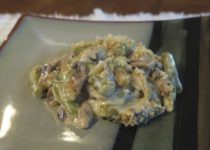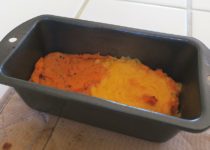Probiotic Lemon Dill Sauerkraut in a Traditional Crock
I was at an Earth Day event a couple of weeks ago and came across a demonstration of making Lemon Dill sauerkraut. I had been wanting to try to make sauerkraut at home but it seemed too hard. With recipes that said to fill a clean 33 gallon trash can, it was just too much. This is way too much kraut for me (BH is NOT a fan of kraut). And most recipes were lacking details – how much cabbage, how much salt?
Lately, using a 2 quart Mason jar for sauerkraut has become popular. This is cool for being able to see your kraut ferment. But the downside is you have to keep it in a dark place out of sunlight. I loved the whole idea of a traditional fermenting crock and was able to find one in a 2 liter size (Humble House Sauerkrock). While I do not get as much a show, I had less worry about where to put the crock. The crock is also designed to release gas naturally through a water lock. A Mason jar does not do this, you need to open it regularly to let gas out.
So here is my successful recipe for sauerkraut, modified a little from the Lemon Dill Sauerkraut shown to me by Marty Johnson from Caspar, California.

Ingredients
- A container that will hold at least 1 gallon to mix everything together - better if it is larger than that.
- A 2 liter fermenting crock (I used the Humble House Sauerkrock)
- 4-6 pounds of green cabbage
- 2 Tablespoons Kosher Salt
- 4 Tablespoons lemon juice
- 1 Tablespoon dried dill
Instructions
- Wash cabbage and remove a couple of outer leaves. Set aside. Cut the cabbage heads into quarters and cut out the core. Slice the cabbage thinly (I used a mandolin cutter at 1/4 inch but I think it should be thinner). Put it in your large container.
- Add the salt and mix well. I cleaned my hands and used them. With the large volume, this was much easier than using a spoon! Add the lemon juice and dill and mix well. With the dill, it is pretty easy to see if everything is getting mixed together.
- Set your container aside for 2 hours. You should see brine (liquid) forming on the bottom of your container and the cabbage should glisten with moisture. Then it is ready for the crock.
- Marty likes to mix in 4-5 gloves of garlic, chopped fine, at this time. I forgot to do this and the kraut tastes just fine.
- Grab the cabbage a handful at a time and put it in your crock. Press down firmly on each handful to remove air pockets. You should see some brine (liquid) rise to the top when you press down. When all the cabbage is in the crock, cover it with the outer leaves you saved in the first step. Add weights to keep the cabbage submerged. If your crock does not have weights, put some water in a quart zipper bag, enough to hold the cabbage down but still be able to close the crock. Be sure the zipper bag is well sealed then put it in the crock on top of the cabbage.
- Add water to the crock rim, put the cover on it, and put the crock someplace out of the way. A dish under the crock will catch any spills. Check every day or so to be sure the cabbage stays in the brine.
- I let mine sit 7 days, but if you wanted a more sour flavor, you could let it sit longer. If you see any white stuff on top, spoon it off, but the kraut should be OK. Brown stuff on top and a "decay" kind of smell probably means the batch is spoiled.
- When ready to stop fermenting, open the crock, take off the weight and outer leaves, then spoon the rest into smaller storage containers, pressing down firmly. Pour any remaining brine over the top and store in the refrigerator. Marty says it will keep for up to a year. I don't expect mine to last that long!
Notes
Play around with ingredients. Caraway seed in place of dill is a traditional seasoning. Many people mix green and red cabbage with carrots. Some add a chopped apple. You do not necessarily need the lemon juice - it is just a nice flavor with the dill.
Homemade sauerkraut is much crunchier than store bought. More like coleslaw texture. Some people like to cook sauerkraut but then you don't get the probiotic benefits.
The cook time in the recipe is the time waiting for the brine to form. You will "work" for about an hour chopping cabbage, mixing stuff up, and getting it into the crock. Remember you will wait another week before it is ready to serve.
Nutrition Facts
Lemon Dill Sauerkraut
Serves: 1.5-2 quarts
|
Amount Per Serving: 1/2 cup
|
||
|---|---|---|
| Calories | ||
| % Daily Value* | ||
| Total Fat 0 | 0 | |
| Saturated Fat | 0 | |
| Trans Fat | ||
| Cholesterol | 0 | |
| Sodium | 0 | |
| Total Carbohydrate 3 | 1% | |
| Dietary Fiber 4 | 16% | |
| Sugars | ||
| Protein 1 | ||
| Vitamin A | Vitamin C | |
| Calcium | Iron | |
* Percent Daily Values are based on a 2,000 calorie diet. Your daily values may be higher or lower depending on your calorie needs.
A Life in Harmony











ohhh I’ll have to try this! I have a fermenting crock just waiting to be filled with cabbage this fall, and this looks more fun than the basic recipe I was going to use.